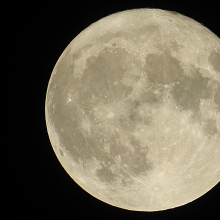The moon and its fickle phases are analysed in this week's question. Does someone in Australia see the same full moon at the same time as someone in the UK? Does being on the other side of the world change the view? Plus, we ask why travelling backwards makes some people ill.
In this episode

00:00 - When there is a new moon in England , What do Aussies See?
When there is a new moon in England , What do Aussies See?
We put this to Dr Dominic Ford from the Department of Physics at the University of Cambridge, also familiar to listeners of the Naked Astronomy Podcast...
Dominic - One thing which often surprises people when they travel long distances is that the Moon appears in different orientations from different places on the Earth. So for example, from the UK, you might see a crescent Moon on the left side of the Moon, on the equator you might see a smiley face with the bottom of the Moon illuminated and then from Australia, you might see a crescent on the right hand side. That's because the Earth is curved and so different people have a different sense of what direction is up and the whole sky appears rotated. But although the Moon can appear rotated, it tends to appear with the same phase, that is the same amount of the Moon's disk is illuminated, from any place on the Earth. That comes down to where the Moon's phases actually come from, which is the orbit of the Moon about the Earth. The Moon orbits once every 29 days around the Earth and at one point in the month, the Moon will appear quite close to the Sun and we will see the back face which isn't illuminated by the Sun, and that's a new Moon when you can't see the illuminated disk of the Moon. Two weeks later when the Moon has gone halfway around the Earth, we see the same side of the Moon which is being illuminated by the Sun and we see a full Moon. And so, the simple answer is that the phases of the Moon come down to the orbit at the Moon about the Earth, not where you are on the Earth, and so it is exactly the same time wherever you are.
Diana - The Moon should appear to be the same no matter where you are on the Earth if slightly rotated, but surely, that's too easy... Dominic - The slightly more complicated answer is that as you move around on the Earth, you're seeing an ever so slightly different face of the Moon. Imagine that you're holding an orange in front of your face and you move your head a few centimetres from side to side, you see a little way around the left or the right side of the orange.
The same thing happens moving around on the Earth, but the Moon is a very long way away. It's 400,000 kilometres away. The Earth is only 6,000 kilometres across. And so, you can only see about 1 degree around either side of the Moon. But that does mean that when one person sees the Moon being totally illuminated, another person will see 1 degree around the unilluminated side of the Moon. And so that leads to a difference of about an hour and a half in when people see the Moon being completely full. You need a very good telescope to see that and it'd be a very challenging observation, but there is a very small difference there.
Diana - One vantage point might allow you to see a tiny bit of the Moon which other people can't. Even the exact times of Moon phases given by calendars are calculated as if one was standing right in the centre of Earth with the 5 Ã?,½ thousand degree iron-nickel core around you. I don't think you'd see much of the night sky from there.










Comments
Add a comment